Dragon Door Interviews Pro MMA Fighter and RKC Instructor Mike Medrano
by Adrienne Harvey, PCC-TL, RKC-2, CK-FMS, Primal Move Nat'l Instructor
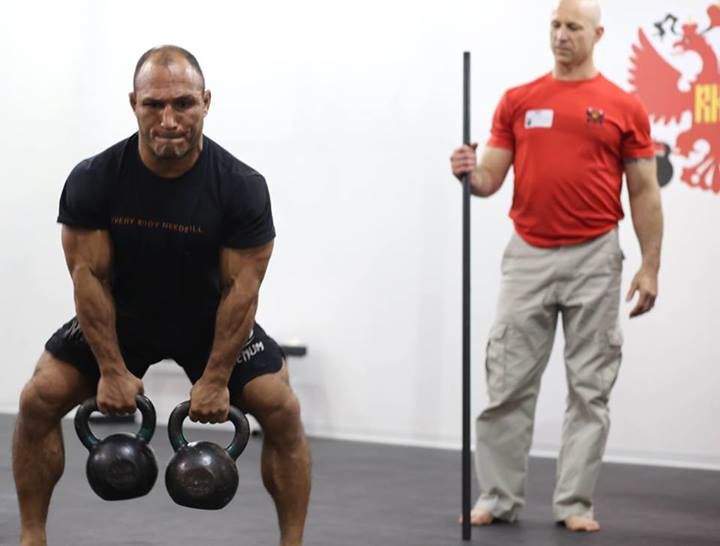
Dragon Door: You've been an athlete for a very long time, how did you get started?
Mike Medrano: My mom knew I needed to find an outlet. When I was twelve, we were at a local fair in Bayonne, New Jersey and I saw a powerlifting and Olympic lifting team doing a presentation. I loved watching the guys lift weights and asked if I could go up on stage. They let me lift a little that day then immediately asked me to join the team. Lifting made me a lot stronger, and I competed in Olympic lifting from age 12 to 16. Once I started playing football I really fell in love with it—football carried me all the way through college and beyond. I competed in football, wrestling and track in high school, then continued with football and track in college. I've been training all year round for a long time.
Dragon Door: What's your secret to successful year-round athletic training?
Mike Medrano: Variety. And especially when I was a kid, having good coaches who understood I had a lot of energy and potential. I didn't have a father to guide me in a good direction, and because I grew up in the inner city, my mom tried to find good male role models for me. I really connected with my football, Olympic lifting, and track team coaches. And I always played basketball, because in the inner city basketball courts were everywhere. I wasn't tall enough to really be great at it, so even though I am a very good basketball player, it wasn't something I could go to college or pro playing. But, I believed that I could with football, given my strength and talent. And it carried me all the way through school. I competed in track because I wanted to get faster for football. So while I trained all year round, I did it to be in the best possible shape for football.
My mom was raising three kids—I was the oldest—and we didn't have much money. Mom made sure I knew it was very important to go to college. But I knew that I couldn't go to college without a scholarship. My coaches for football and track told me I could get a college scholarship for either sport if I could stay focused. So, in high school I didn't get a job—my job was working out. Mom told me that it was my job to get good grades and play sports. And I was able to get a scholarship, go to college and get a degree.
Dragon Door: What is your degree?
Mike Medrano: I have a triple major in education, history and political science. I wanted to be in education so that I would have the same schedule as my children. When I was 30, my son was born, and I went straight into education. But, with the fighting between governor Christie and the board of education, many non-tenured teachers—myself included—lost their jobs. At the time I transitioned to MMA fighting full time and soon found a job as a
trainer.
Dragon Door: How did you transition from college and teaching to MMA?
Mike Medrano: In college, I didn't complete all four years in athletics. For three years I led the team in rushing and touchdowns, then my Mom was diagnosed with a brain tumor. I transferred schools to be closer and started working full time so I could take care of her. It took about a year for her to have the tumor removed, heal, and rehabilitate so she could take care of herself again. Once she was healthy I went back to Monmouth University, but I couldn't play on the football team because I had transferred schools. Transferring from a Division III school back to a Division I school meant I had to follow the NCAA regulations and not play for Monmouth University anymore.
After I graduated, I started pursuing semiprofessional football, Canadian football, arena football, and I even went to the NFL tryouts. At the NFL level, you need to be in shape when you get to camp. Even though I had all the skills I needed, I knew I couldn't just show up, work out with them and be ready. So I started with martial arts to get in shape. I practiced Capoeira for three years, then I started with jujitsu and American kickboxing. All of it added together nicely and I enjoyed the training—and exercise benefits. In martial arts I had to get smaller—since I’d been bigger for football, I had to learn how to get skinnier. After I knew I wasn’t going to get into the NFL, I played a little arena football but it didn't pay much. Instead I put all my energy and focus into fighting. I went professional in 2007 at age 28 and have been fighting every since.
Dragon Door: How did you find kettlebells?
Mike Medrano: One of my jiujutsu instructors had a student at AMA (American Martial Arts in Whippany) who brought his
kettlebells to work out. He taught me the swing, snatch, and the Turkish get-up which is very important for MMA. We'd do one minute of kettlebell swings, a minute of get-ups, a minute of snatches—going for five minutes on, then resting for one minute. So, whichever kettlebell exercises we did, we did them at the pace of an MMA fight. I loved it, and the way it felt was realistically comparable to a fight. I didn't have to get bigger and it kept me safe. I could even work with kettlebells before or after an MMA workout—which is great because you really can't beat people up all day long because it takes a toll on your body. Before, my hands and neck would hurt, and if I slammed someone the wrong way, my back would hurt. After an MMA training session, you really don't want to lift heavy—while I could squat 500 pounds, I don't always want to put 500lbs on my back. Kettlebells really work perfectly for MMA—I can use my energy to work on my
conditioning and strength without getting big. And it is safer, so it matches up perfectly.
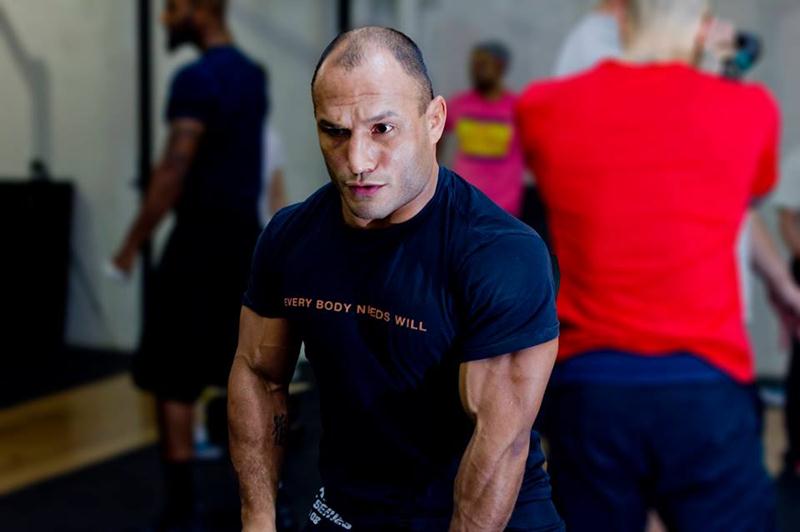
Dragon Door: You specifically mentioned that the get-up is good for MMA. How has practicing it helped you?
Mike Medrano: In a fight, let's say I lost the wrestling takedown and someone is on top of me. I literally can put my hand on my opponent's neck or shoulder and if I simulate the Turkish get-up movement, I can actually get up and ready to throw an uppercut or overhand right. As soon as I stand up, I'll throw a punch. The get-up with a kettlebell and in a fight when someone is on top of me is the same exact movement—just faster. It really helped and as I got stronger, it became more and more difficult for someone to stay on top of me and beat me up. I love the get-up.
Dragon Door: When did you start training others?
Mike Medrano: About five years ago I started a job with Kevin Mullhall, a UFC referee. I started teaching jiujutsu, kids’ jiujutsu, adult Muay Thai, and adult conditioning—which is where we added kettlebells. I started working in New York as a trainer about a year and a half ago. I’d noticed a close friend of mine since childhood talking about kettlebells on Facebook. I sent him a messaging saying how much I loved kettlebells and how they had helped with my MMA career. He responded, we reconnected and soon after he offered me a job at his gym in New York City. I train a few celebrities, but mostly train models and people who are on TV who want to look their best. They don't want to fight, but they need a different way to train since they're looking for a different experience than just going to a gym to lift weights. So, I teach them a little bit of Muay Thai, boxing, and some jiujutsu to get their core tight. We also use kettlebells because they're safe and allow trainees to burn a lot of fat and get trim. Basically, I get my clients TV ready.
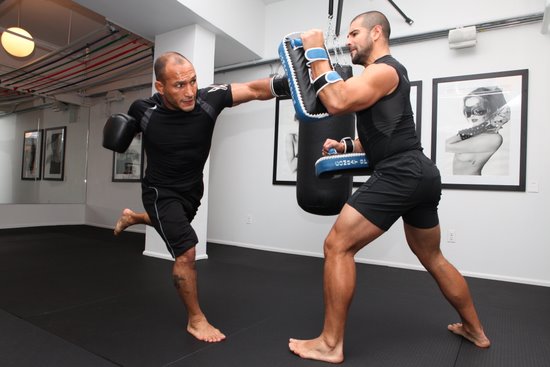
Dragon Door: How did you decide to attend an RKC workshop?
Mike Medrano: A few months ago, my boss said, "Mike you're a great trainer, what do you want to do this year?" I told him that I wanted to go to seminars to help me improve and master my art, job performance, and career. Since I was a kid, coaches taught me Olympic lifting, football, and track and now I wanted to be that type of professional. I wanted to learn the best ways to communicate the movements, and to help clients improve their technique for maximum benefit.
So, my boss signed me up for the
RKC. It was an awesome experience—if you ask Phil Ross, he'll say I was like a kid in a toy store. Even though I'd seen the basic movements before, the meticulous approach to form was really exciting. I could do all the exercises with no trouble, but I felt like a big kid because I love learning, and especially loved the way the lessons, movements, and techniques were taught. I was always the first person up front with my eyes wide open adding tool after tool to my tool belt.
Dragon Door: What's the biggest thing you learned at the RKC?
Mike Medrano: I learned how to really help someone with their form while they're using a kettlebell. Also, I learned how to be very specific, but also very patient when teaching kettlebell exercises. When I originally learned about kettlebells in MMA, it wasn't pretty—it was about getting our heart rates up, controlling a 30kg kettlebell in any way possible, and mimicking a fight. But when I worked with
Phil Ross and the other instructors at the RKC, I learned about stability, control, and performing the movements correctly. The new information allowed me to really master the joints and muscles involved with the movements. I learned to slow the movements down, be patient, and really learn how and what we were doing.
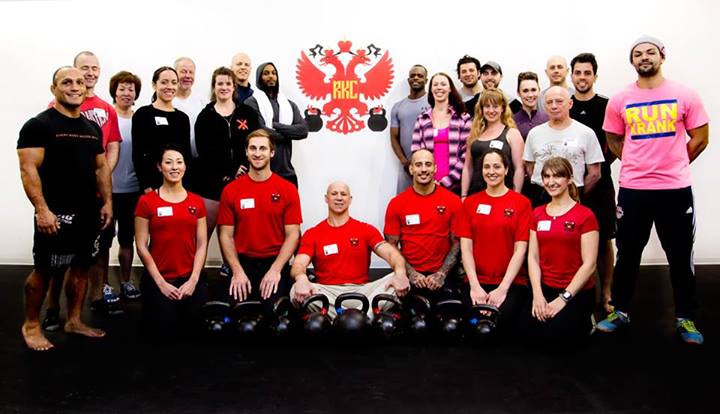
Dragon Door: When's your next fight?
Mike Medrano: I fought three times this year, and want to take a little vacation from fighting because it's hard on my wife! Since we've been together, I've fought 35 times including 22 professional fights. In 2010 I broke my jaw, last year I had MRSA and almost lost my leg, and in my most recent fight I fractured my eye socket. Physically, my body can still continue to do it, my mind and spirit are ready, but my family is sometimes drained by watching me go through these trials and tribulations. I'm really doing well as a trainer, and don't need to fight to supplement my income, but I am having a lot of success with fighting, so I'm going to be patient.
In March I'm competing in the CrossFit Games. The host of the RKC here in New York offered to sponsor me because he saw my potential and how much fun I was having at the RKC Workshop. My boss is also encouraging me to compete because there's less chance I'll get hurt as compared to a fight. If I get hurt in a fight, then I have to take off a few days from work—and training can be a tough sell when I’m black and blue everywhere! My clients love me, but these are some of the reasons I'm considering fighting just 2-3 times a year.
Dragon Door: What's your favorite kettlebell lift?
Mike Medrano: Snatching—it maximizes my explosiveness and requires strength to lock it out overhead. It's my favorite as far as kettlebells are concerned, and it's safe too.
Dragon Door: What's your next goal?
Mike Medrano: This year my goal is to improve my technique with the Olympic lifts. Even though I have known the lifts since age 12, my muscles have grown so much that I need to adjust my shoulder flexibility. And I want to get ready for the CrossFit games in March. I can at least make it to the regional or farther if I stay focused and work on my technique. My conditioning is already there from MMA, and my strength is solid from all my lifting. I just need to put everything together by working on my technique, and kettlebells will help me continue to work on that technique past the barbell. If I am tired, instead of doing a heavy barbell clean and jerk, I can still work on my explosiveness with a set of 20 kettlebell swings. It's a safer way to continue training, and kettlebells are a very good complement to all of my training.
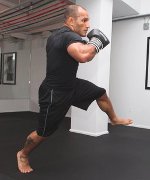 Mike Medrano trains clients at WILLSPACE in New York and can be contacted through willspace.com. He fights professionally with AMA Fight Club.
Mike Medrano trains clients at WILLSPACE in New York and can be contacted through willspace.com. He fights professionally with AMA Fight Club.
Back